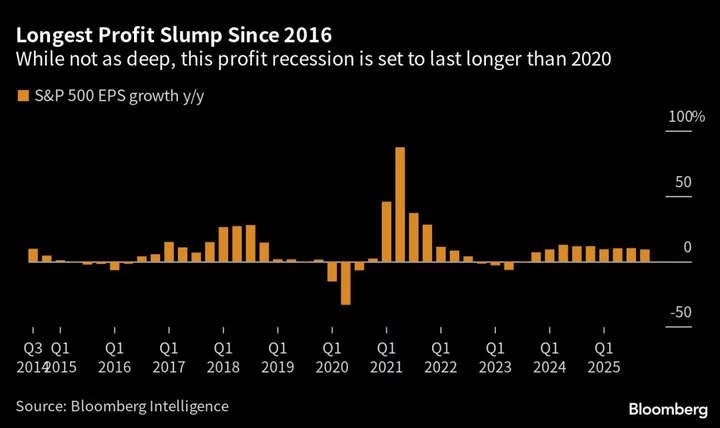As the US economy teeters on the brink of recession, Wall Street is already enduring what could turn out to be the most prolonged corporate profits downturn in seven years.
With the first-quarter earnings season drawing to a close, the profits of S&P 500 companies are estimated to have dropped 3.7% on average, compared to a year ago. While data compiled by Bloomberg Intelligence shows that 78% of firms surpassed forecasts, that’s less impressive than it sounds, given analysts had slashed their expectations before the season kicked off.
More crucially, it was the second straight quarter of earnings declines for corporate America. Bearish earnings forecasts now center around the April to June period, for which a 7.3% profit slump is penciled in, according to data compiled by Bloomberg Intelligence. And the pinch from higher interest rates and wilting consumer demand will extend into the third quarter of 2023, analysts reckon, backtracking on earlier predictions that earnings recovery would kick in around then.
That implies a longer profit recession than during the pandemic. An earnings drop of more than three quarters was last seen in 2015 to 2016, when the Federal Reserve started its last interest rate hiking cycle.
Unsurprising then that the S&P 500 index has posted no gains since major Wall Street lenders kicked off the earnings season in mid-April.
“Optimists would note that the worst analysts’ prognoses have not come true and large proportion of companies exceeded their targets in the first quarter,” said Marija Veitmane, senior multi-asset strategist for State Street Global Markets. “Pessimists would say earnings are declining, and future guidance is weak.”
Here are the key takeaways from the earnings season, and what to look for in coming quarters:
Margin Pressures
A slowing economy is exerting a toll on profit margins, which according to consensus forecasts won’t recover before the final quarter of 2023. PayPal Holdings Inc. was among companies warning recently that adjusted operating margins will not grow as quickly as anticipated. Tyson Foods Inc. was another that cut margin guidance.
“While first-quarter earnings appear strong, we do see cracks emerge where sales growth is outpacing earnings growth – a squeeze on corporate margins,” said Anneka Treon, a managing director at Van Lanschot Kempen.
Companies have resorted to laying off workers, with tens of thousands of jobs culled across industries, from tech to retail. The impact should show up in the April-through-June period earnings.
Morgan Stanley strategist Michael Wilson predicts “additional margin downside” over the coming months, with labor costs a major headwind and a softer economy crimping companies’ pricing power.
Bank Headwinds
Booming interest income, trading revenues and deposit inflows at the big banks enabled lenders’ earnings to largely shrug off March financial stress, with JPMorgan Chase & Co CEO Jamie Dimon declaring the crisis near an end.
But other headwinds loom. As more Americans fall behind on payments, the four biggest US banks saw bad consumer loan write-offs rise 73% from year-ago levels. Provisions soared, while smaller firms such as Lazard Ltd. face pressure from slower dealmaking.
“The fallout in smaller businesses as banks lending is greatly reduced could also show in financial markets as overall business activity slows, and also it should impact the consumer,” said Paul de la Baume, senior market strategist at FlowBank SA.
The problems could ripple into commercial real estate, according to Franklin Templeton Investments’ Chief Executive Officer Jenny Johnson, who noted that small banks account for 25% of the lending to this sector.
High-profile mortgage defaults by companies such as Brookfield Corp. and Columbia Property Trust have already rocked the property sector, leaving the S&P 500 real estate index flat this year, bucking gains in the wider benchmark.
Tech Dominance
Technology firms were a first-quarter bright spot, with Apple Inc., Meta Platforms Inc., Google-parent Alphabet Inc. and Amazon.com Inc. all beating expectations. They are also benefiting from signs the Federal Reserve has stopped hiking rates.
Still, sector earnings are expected to decline more than 7% in the second quarter. What’s more, tech comprises 35% of the S&P’s market-cap share, but just under 30% of earnings, analysts at Bloomberg Intelligence note. They said tech, media and telecoms’ earnings growth is expected to lag the broader index until 2024, leaving shares vulnerable.
Thomas Hayes, chairman of Great Hill Capital, is among the investors looking to capitalize on short-term tech pullbacks. The upcoming tech earnings slump is “known information and the market will start to look forward to the 2024 earnings recovery in coming months,” Hayes said.
Artificial intelligence developments could prove key, having already powered rallies at Nvidia Corp., Microsoft Corp. and Alphabet. All three have raced to add AI features to their products, making them among the biggest contributors to this year’s S&P 500 gains.
China Support
China’s reopening has been crucial for markets, with luxury and commodity businesses reaping outsize benefits. While US companies are less reliant on Chinese sales than European and Asian peers, companies like Coach owner Tapestry Inc. and casino operator Las Vegas Sands reported an earnings boost from China’s rebound.
But while first-quarter Chinese growth roared to a one-year high, credit and consumer demand appear to be sputtering. “The best of the momentum is likely behind us,” JPMorgan strategist Mislav Matejka wrote.
Peak buybacks
Corporate share purchases have long been one of the biggest sources of support for Wall Street and for companies’ own earnings per share. Now they are waning as borrowing costs rise and cash reserves shrink.
S&P 500 constituents’ actual first-quarter buybacks were 21% below year-ago levels, according to Goldman Sachs Group Inc. And upcoming quarters could see fewer share-buying announcements, Goldman says, predicting buybacks this year at $808 billion, versus $923 billion in 2022.

